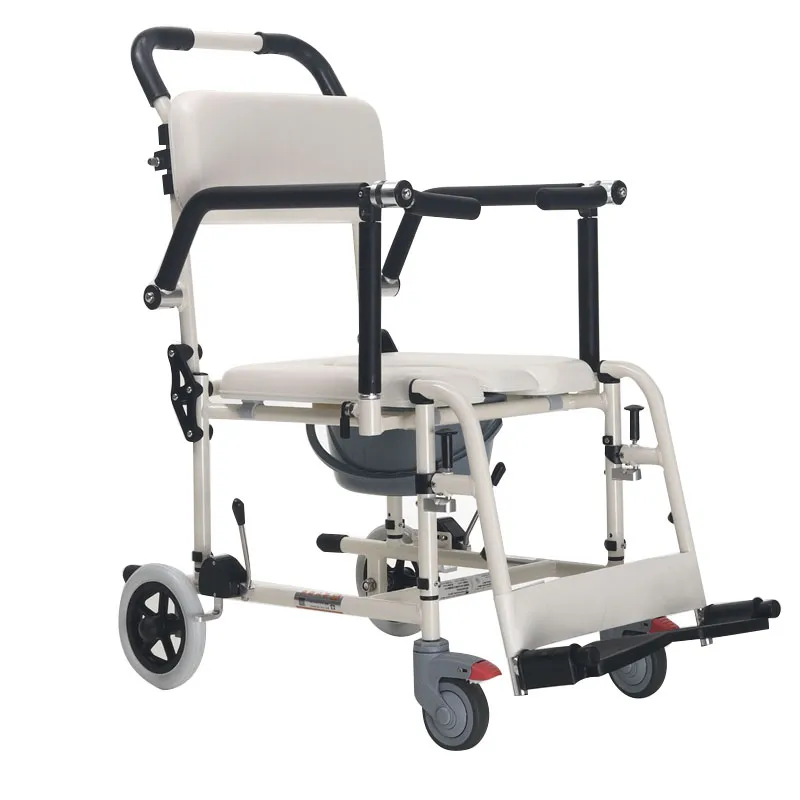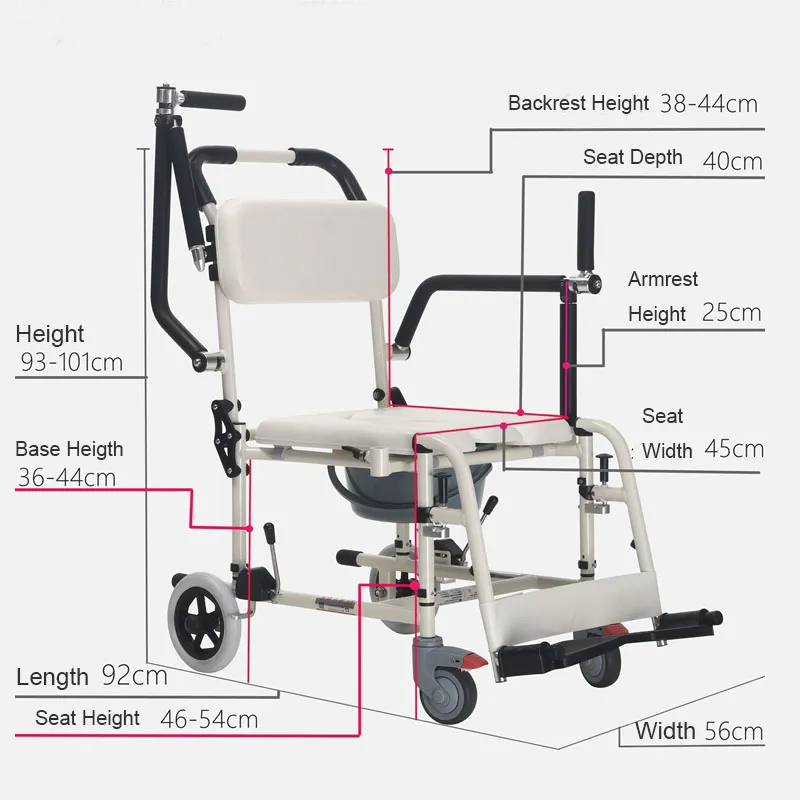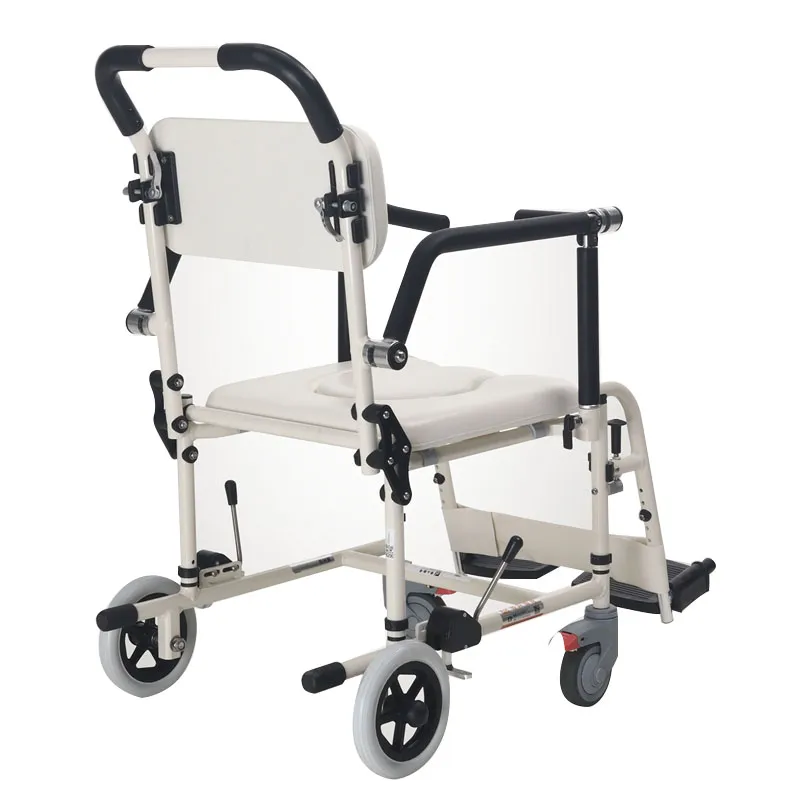In the field of modern rehabilitation care and elderly assistive devices, the commode (toilet) wheel chair, as a special wheelchair with both mobility and toileting functions, is increasingly being used in daily care for different groups of people. Due to its unique design and function, the commode wheel chair can not only help people with limited mobility to complete the toileting process independently, but also greatly reduce the burden on caregivers.
So, who is suitable for using the commode wheel chair? This article will conduct a comprehensive and professional analysis around this issue, systematically exploring the functional characteristics of the commode wheel chair, the applicable population, and why these people need to use the commode wheel chair.

What is a commode wheel chair?
The commode wheel chair is an assistive device that combines the functions of a wheelchair and a toilet, designed for elderly people, patients or rehabilitators with limited mobility. Unlike ordinary wheelchairs, the commode wheel chair has a cleverly designed lower seat that can accommodate a bedpan or commode bucket, where users can sit to use the toilet. The commode wheel chair can not only provide mobility assistance, but also help users go to the toilet without timely sanitary facilities, avoiding the discomfort caused by mobility problems.
The commode wheel chair is not only suitable for bedridden patients, but also for the elderly or patients who can sit up but are inconvenient to go to the bathroom on their own. It is a convenient and practical tool, especially for those who are bedridden for a long time or have limited mobility. The device is usually equipped with a comfortable seat, adjustable armrests, foot pedals and other designs, which maximizes the comfort and safety of the user.
The commode wheel chair usually includes the following parts:
· Removable bedpan or fixed commode: located under the seat for easy cleaning.
· Waterproof and easy-to-clean seat material: adapted to toilet needs.
· Wheels with brake system: keep stable and prevent sliding during toileting.
· Armrests and pedals: provide additional support to help users get on and off the wheelchair.
· Adjustable height design: easy to dock with home or hospital toilets, or adjust to the best height for the user.
Different models of commode wheel chairs may also be equipped with additional features such as reclining backrests, thickened seat cushions, splash covers, etc. to meet the specific needs of different patients.

What are the advantages of toilet wheelchairs?
Before discussing who should use toilet wheelchairs, it is necessary to understand their functional advantages. The reason why it can become an indispensable device in the nursing process is mainly because toilet wheelchairs have the following advantages:
1. Provide convenient toilet solutions
2. Improve the quality of life of users
3. Reduce the burden of care
4. Improve safety
1. Provide convenient toilet solutions
For the elderly, patients or patients in rehabilitation who are bedridden or have difficulty in moving, daily toileting has become a very difficult problem. Ordinary wheelchairs cannot provide convenient toilet support, but toilet wheelchairs can solve this problem. Its design combines the mobility of wheelchairs and the functions of toilets. Users can solve toilet problems at home or in the hospital at any time without waiting for help from others or worrying about the distance of the bathroom.
2. Improve the quality of life of users
The design of the commode wheel chair maximizes the independence of people with limited mobility. For many patients who are bedridden or recovering, being able to use the toilet independently is an important step in restoring their quality of life. The commode wheel chair not only helps users reduce the embarrassment and discomfort when using the toilet, but also improves their self-esteem and mental health, allowing them to maintain greater independence in life.
3. Reduce the burden of care
In families that require long-term care, the commode wheel chair can greatly reduce the burden on family caregivers. The traditional toileting process may require caregivers to move patients from the bed to the bathroom, which is cumbersome and requires high physical strength from caregivers. The emergence of the commode wheel chair can help caregivers reduce the labor intensity of this process and improve the efficiency of nursing work. Users can complete toileting on the commode wheel chair, and caregivers only need to assist or provide simple help.
4. Improve safety
For elderly people or patients with limited mobility, falls are a common safety hazard, especially when going to the bathroom. The toilet wheelchair provides a safe option, allowing users to complete toileting in a fixed environment, avoiding injuries caused by unstable gait or falls. At the same time, many toilet wheelchairs are also equipped with brakes or safety belts to ensure the safety of users when using them.
After understanding these functional advantages, we can analyze more specifically which groups of people are most suitable for using commode wheel chairs.

Who should use commode wheel chairs?
People who should use commode wheel chairs:
1. People with mobility impairments
2. Elderly people
3. Patients recovering from surgery
4. Long-term bedridden patients
5. Patients with special diseases
1. People with mobility impairments
The first to bear the brunt are people with various types of mobility impairments. Including people who cannot walk freely due to illness, injury or physical degeneration. Common people with mobility impairments include:
· Stroke patients: Stroke often causes hemiplegia and muscle weakness, which affects patients' independent walking and toileting. The toilet wheelchair can help stroke patients complete toileting actions with limited autonomy and maintain dignity in life.
·Spinal cord injury: Patients with high or low spinal cord injury usually completely or partially lose lower limb function, and toilet wheelchair becomes an important auxiliary tool for them.
·Patients in the recovery period of lower limb fracture: Activities need to be strictly restricted in the early stage of fracture. The use of commode wheel chair can meet the toilet needs without risking aggravation of injury.
2. Elderly people
As they age, the elderly often face problems such as decreased muscle strength, osteoporosis, and decreased balance function, making toileting a challenging activity. For the elderly, especially those over 90 years old, the use of commode wheel chair is extremely important:
·Reduce the risk of falling: The risk of falling when the elderly go to the toilet is extremely high. The toilet wheelchair provides a stable toilet platform, which reduces the chance of falling.
·Improve the quality of life: Being able to go to the toilet conveniently in your own space, without relying on too much care, improves life autonomy and dignity.
3. Patients in the recovery period of surgery
After surgery, especially patients with joint replacement, spinal surgery, and heart surgery, usually need to avoid strenuous activities for a period of time. The commode wheel chair can help them use the toilet safely during recovery:
· Reduce postoperative complications: Reduce unnecessary walking and prevent wound tearing or bleeding.
· Convenient nursing process: Nurses can directly push patients to the vicinity of the bathroom, which is convenient and quick.
4. Long-term bedridden patients
Long-term bedridden patients, including patients with advanced chronic diseases, vegetative patients, severely paralyzed patients, etc., are usually unable to move on their own, and toilet wheelchair has become a key equipment in their daily care:
· Convenient to clean up excrement: Reduce the embarrassment of patients using potties in bed and improve sanitary conditions.
· Improve skin conditions: Avoid bedsores caused by long-term contact with excrement.
5. Patients with special diseases
Some special diseases, such as Parkinson's disease, amyotrophic lateral sclerosis (ALS), multiple sclerosis (MS) and other neurological diseases, are also very suitable for commode wheel chairs due to movement disorders or muscle weakness:
· Improve independence: In the early or middle stages of the disease, the use of commode wheel chairs can extend the patient's self-care time.
·Protect patient safety: Reduce the risk of patients falling during toileting due to limb stiffness or tremor.

Applicability of toilet wheelchair in different environments
1. Home environment: In the home environment, toilet wheelchair is usually used as a temporary toilet equipment, especially for families with limited space or difficult bathroom renovation. The toilet wheelchair can be pushed to the bedside for use when needed, and it is easy to clean after using the toilet, which effectively improves the convenience of home care.
2. Medical institutions: In hospitals, rehabilitation centers, nursing homes and other institutions, toilet wheelchair is one of the standard configurations. It can meet the toilet needs of short-term or long-term hospitalized patients, especially the care needs of postoperative rehabilitation patients and spinal cord injury patients.
3. Community nursing homes: In nursing homes, day care centers and other places, toilet wheelchair is also widely used. It helps the elderly maintain basic self-care, delays the process of disability, and improves overall life satisfaction.
How to Get Competitive Prices for Medical Equipment from China?
Buying directly from manufacturers like Yikang Medical is the key. We offer factory-direct pricing, regular discount promotions, and efficient supply chain management. Request a quote today and discover how our prices compare to other suppliers. We also help optimize shipping costs and delivery time.

